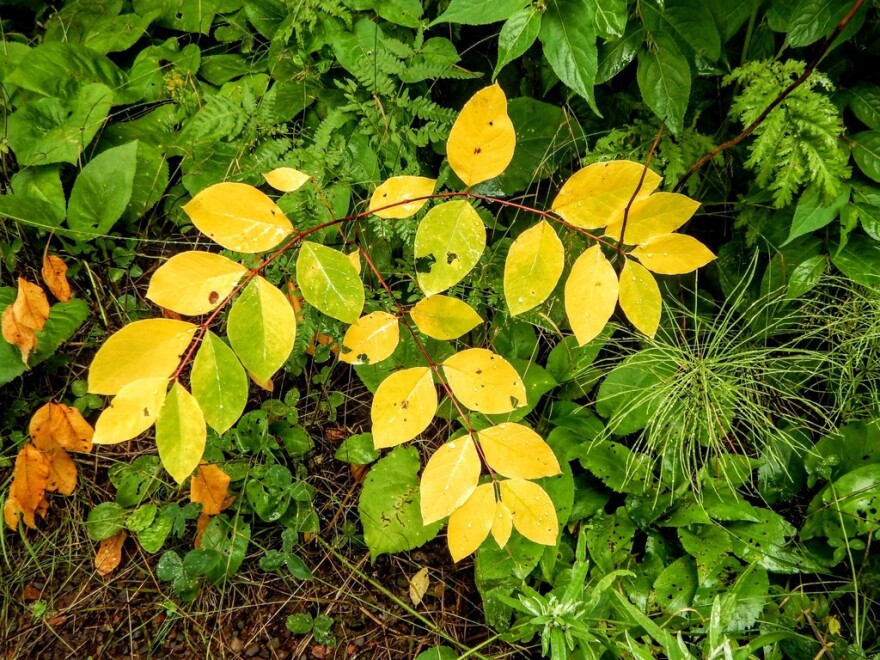We're hungry for reports for our Phenology Talkbacks segment. Please don’t hesitate to reach out with your observations, nature tales and insights! Get in touch with me (smitchell@kaxe.org), John Latimer (jlatimer@kaxe.org), or text "phenology" to 218-326-1234.
Fall-owing the seasonal signs

Last week was all about yellow flowers, and this week brings the first yellow leaves. John heralds the first news of fall: the spreading dogbane leaves are beginning to turn.
Each year, he keeps a close eye on the spreading dogbane in his yard. This plant is a wonderful one to observe, due to its intrinsic beauty (deep green leaves, bright red stems, and delicate white bell-shaped flowers), attractiveness to pollinators, and importance to late-summer phenology. It is the first plant to turn yellow in anticipation of autumn.
John focuses on the spreading dogbane in his yard, because dogbane along roadsides may turn yellow out of season due to herbicidal sprays. This year, his spreading dogbane turned on August 7, a week later than the average (July 31). The date is quite variable: in 2022, it was 12 days later than average, and in 2018 and 2021, it turned color 11 days earlier than typical.
Other super-early signs of fall include turning leaves on red maples. They tend to turn first at the top of the tree, and it’s very subtle to begin with. John’s sharp eyes (and years of watching) help him out here!

John, perhaps anticipating how I’m going to feel about this news, reminds us that this descent into fall weather isn’t necessarily a sign of impending doom. “Maybe it’s not a descent, maybe it’s just a transition,” he reassures us. “It’s a new season and It brings its own excitement and its own joys and rewards.”
(Let's all repeat that back to him during a cold spell next April.)
Summer’s still sticking around
Luckily for me, there’s still plenty of summer left to enjoy. Late-summer wildflowers are particularly wonderful: last week, John covered the tall yellow ones, and this week he focused on the asters.
Asters are incredibly colorful, coming in shades of white, blue, pink, lavender, yellow, and more. They have many petals (technically these are rays, which are modified leaves) surrounding a central pitted disc embedded with many tiny flowers. The flat-top aster is the first to bloom, followed by large-leaved asters, smooth asters, calico asters, and many-flowered asters.
Plant progression
- Done fruiting: Raspberries
- Fruiting: Pin cherry, black chokeberry, blackberry, blueberry, bluebead lily (not edible), hazelnuts
- Unripe fruit: Chokecherry
- Done flowering: Fireweed, common arrowhead,
- Flowering: Spurred gentian, wild cucumber, flat-topped goldenrod, Canada goldenrod, early goldenrod
- Not yet flowering: Flat-top aster, gray goldenrod
Wetlands
John’s seen plenty of 12-spotted skimmers, darners, and one last ebony jewelwing damselfly. He even managed to capture the ebony jewelwing and get a good look at it: they have beautiful black wings and an amazing iridescent body. Their body can appear electric green or a deep, shiny blue depending on the angle. They are definitely worth a closer look if you can find one this late in the season!
If you’re “banging around on the edge of a swamp” (John’s words, not mine), take a close look at the sedges! They are favorite scaffolding for marsh bellflowers, which are a vining wetland plant with tiny, white bell-shaped flowers.

Hazelnuts
The hazelnuts are ripe! If you like hazelnuts, get out there now to collect them. Because of their high protein and fat content, they are a favorite of many wildlife species including chipmunks, squirrels, woodchucks, Blue Jays, deer, bears, and more. So, competition for them is steep and they disappear fast! John will be surprised if there are any left by next week.
Last year was a particularly productive year for the hazels. They produced so many nuts that even the best efforts of the wildlife weren’t enough to empty the shrubs after a week. Perhaps we’ll luck out two years in a row, but just in case, it’s better to get out there to harvest earlier rather than later.
That does it for this week! For more phenology, subscribe to our Season Watch Newsletter or visit the Season Watch Facebook page.
Funding for this project was provided by the Minnesota Environment and Natural Resources Trust Fund as recommended by the Legislative-Citizen Commission on Minnesota Resources (LCCMR).








